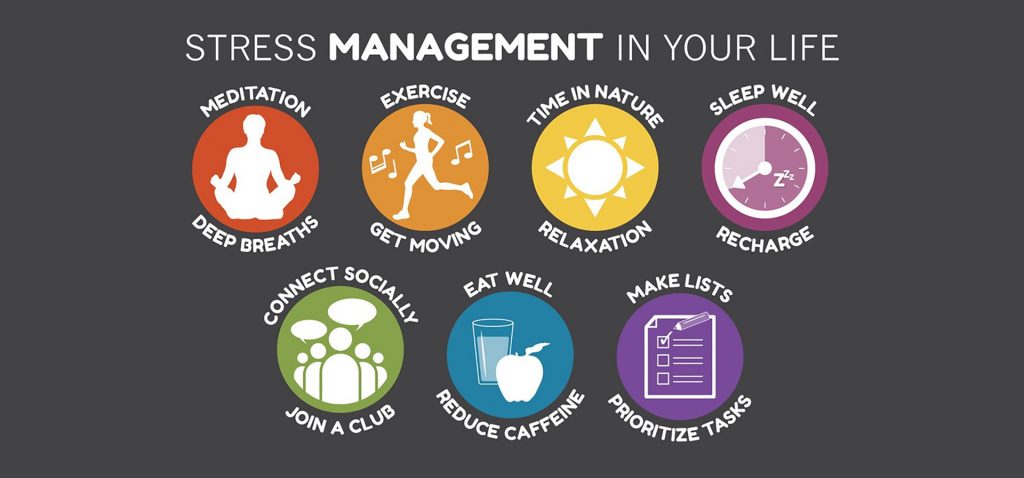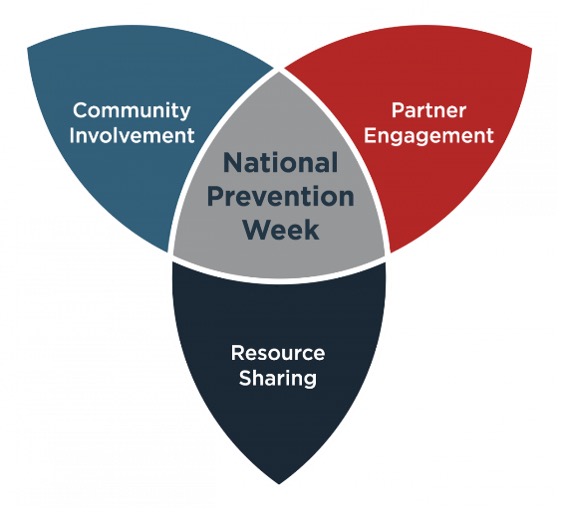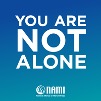SAPAD 2021 SUMMARY
On March 9, 2021 Voices for Prevention (V4P) held its first virtual Substance Abuse Prevention Advocacy Day (SAPAD). The theme for this year was “Restart with Resilience” with a challenge to help us connect, grow, and advocate. The event was sponsored by the Department of Behavioral Health and Developmental Disabilities, Office of Behavioral Health Prevention and Federal Grants.
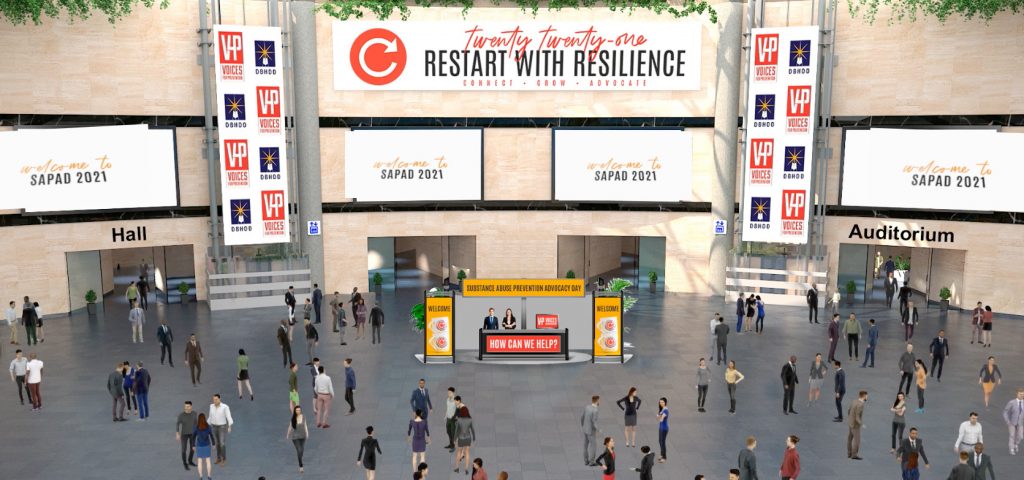
Over 200 individuals and groups logged on to the virtual platform, vFairs, and visited the virtual auditorium, provider booths, attended rallies, and networked in the lounge area. Despite not being in-person attendees still had the opportunity to connect through the chat rooms and via networking room. The energy from everyone was electric and will not soon be forgotten.
The event started at 8:30 a.m. with attendees viewing the welcome video featuring Ester Lopez, visiting the 11 virtual booths in the Exhibit Hall, accessing the schedule for the day at the V4P Information Booth in the lobby, visiting the lounge area chat room, and listening to presentations in the Auditorium.
At 10:00 a.m., the Youth and Adult Rallies were held in separate “rooms.” Speakers at the Adult Rally & Youth Rally included the Governor, the Attorney General, DBHDD Commissioner Judy Fitzgerald, OBHPFG Associate Director Donna Dent, Sen./Dr. Kay Kirkpatrick, Rep. Sharon Cooper, Chair of the House Health and Human Services Committee, Rep.(and preventionist) Steve Sainz, a preventionist, State School Superintendent Richard Woods, Dr. Gregg Raduka, as well as youth speakers Izabelle Wensley and Juan and Marco Borrego.
Dr. Raduka read the Governor’s 2021 SAPAD Proclamation which included the following Whereas clauses:
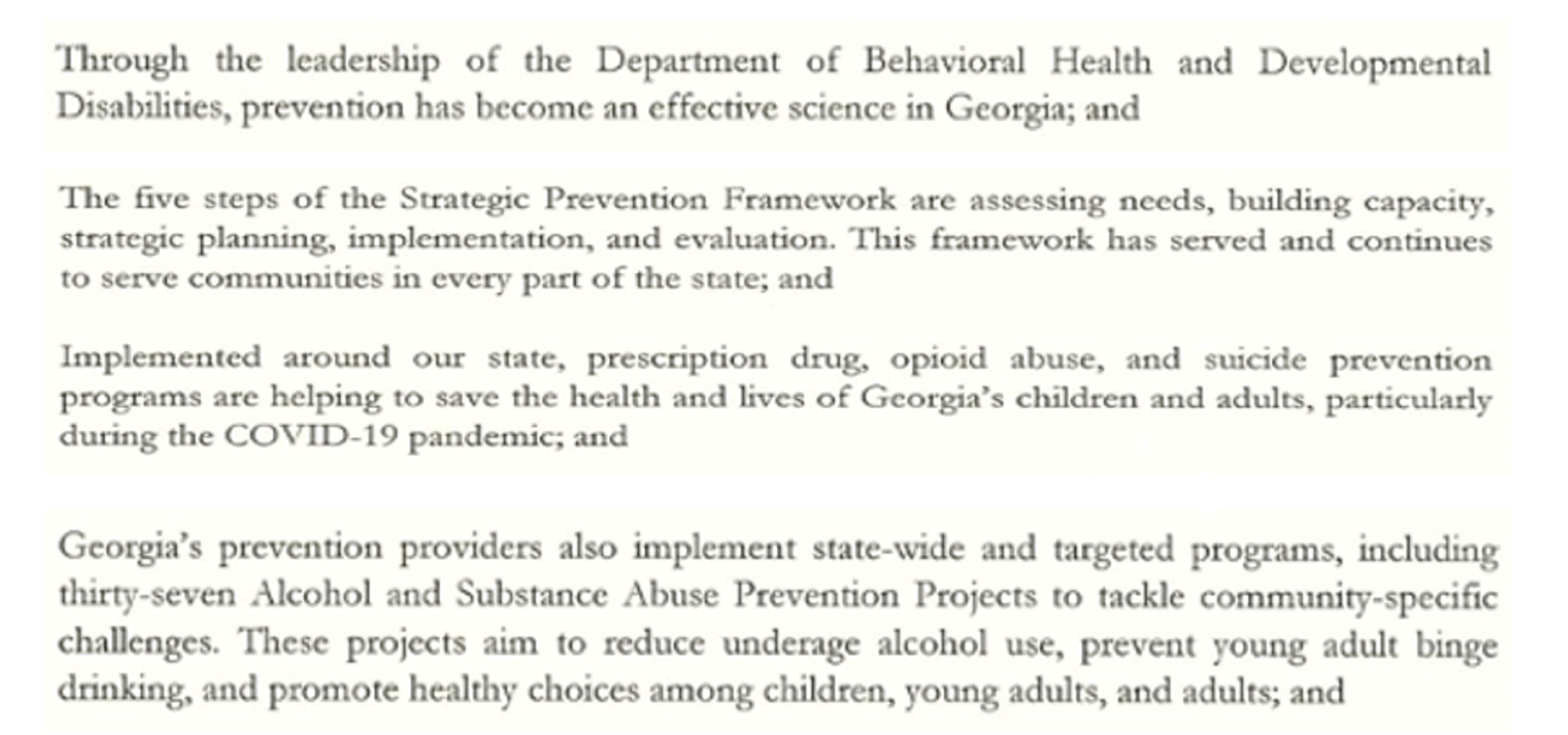
The wrap-up event “What’s Next,” followed at 11:15 a.m. The Wrap-Up guest speakers included OBHPFG Director Jill Mays, advocacy expert Dr. David Jernigan of Boston University, and motivational speaker Yvonne Harvey-Williams. The adult rally and wrap-up event were emceed by Carmen Caldwell of The Council on Alcohol and Drugs and the youth rally was emceed by Morgan Williams with the GUIDE Youth Advisory Council.

National Prevention Week
National Prevention Week (NPW) is a public education platform that promotes prevention year-round through providing ideas, capacity building, tools, and resources to help individuals and communities make substance use prevention happen every day.
NPW culminates in May recognizing the important work that has been done in communities throughout the year to inspire action and prevent substance use and mental disorders.
SAMHSA’s NPW is May 9 through 15, 2021. Each year around this observance, communities and organizations across the country come together to raise awareness about the importance of substance use prevention and positive mental health.
https://www.samhsa.gov/prevention-week/about
Purpose of National Prevention Week
The three primary goals of National Prevention Week are to:
- Involve communities in raising awareness of substance use and mental health issues and in implementing prevention strategies, and showcasing effectiveness of evidence-based prevention programs;
- Foster partnerships and collaborationswith federal agencies and national organizations dedicated to improving public health; and
- Promote and disseminate quality substance use preventionand mental health promotion resources and publications.

Each year, National Prevention Week includes daily themes to focus on major substance use and mental health topics. The 2021 daily themes are:
Monday, May 10: Preventing Prescription Drug and Opioid Misuse
Tuesday, May 11: Preventing Underage Drinking and Alcohol Misuse
Wednesday, May 12: Preventing Illicit Drug Use and Youth Marijuana Use
Thursday, May 13: Preventing Youth Tobacco Use (E-Cigarettes and Vaping)
Friday, May 14: Preventing Suicide
Why Does National Prevention Week Occur in May Each Year?
Originally, SAMHSA chose this timing because it is near the start of summer, an important time for schools, communities, and prevention professionals to re-focus on prevention. Adolescents and full-time college students most often use substances for the first time during June or July, according to SAMHSA’s National Survey on Drug Use and Health (NSDUH) data on adolescents – 2012 (PDF | 704 KB) and NSDUH data on full-time college students – 2015 (PDF | 1.2 MB).
As national participation in NPW has increased over the years, this week now serves as a week-long observance created by SAMHSA to celebrate prevention efforts in organizations and communities across the nation, and across all ages. We know communities make prevention happen every day – not just during NPW – and NPW is the perfect time to promote and celebrate a year’s worth of prevention efforts, as well as get news, ideas, and resources to strengthen daily, weekly, and monthly prevention activities.
Plus, the timing of National Prevention Week still provides a timely opportunity for schools and organizations to host prevention-themed events and activities before the school year ends, raising awareness about this important issue among students and their families. These are key periods of social transitions, a risk factor for youth substance use, and an opportunity to develop or strengthen the community, school, and family bonds that protect young people from substance use and strengthen community health overall. More information can be found in The Surgeon General’s Report on Alcohol, Drugs, and Health.

National Mental Health Awareness Month
National Mental Health Awareness Month in May focuses on bringing tools, resources, and education to the general public. Each year Mental Health America, National Alliance on Mental Illness, and other mental health organizations across the country organize events, webinars, and more to improve mental health access across the country.
Mental health is a hot topic. This is good news. It means the stigma for mental health issues is slowly going away. Mental health issues are finally getting the attention they deserve. Healthcare workers and individuals feel they can discuss mental health more openly. However, that doesn’t mean there isn’t still work to do, however.
As a whole, we often misunderstand mental health because it is hard to define. Additionally, mental health includes several areas. These areas involve one’s social, emotional, and psychological well-being. Mental health affects thoughts, feelings, and actions. When one has positive mental health, they are better equipped to handle stress, be more productive, and realize their full potential.
While we focus on our physical wellbeing, the food we eat, exercise, and getting regular check-ups for vision and dental care, we often forget to take stock of our emotional and spiritual needs. Everyday demands take their toll.
HOW TO OBSERVE
#MentalHealthAwarenessMonth
Share the message. Taking care of our mental health is as normal as eating healthy, exercising, or even saving for the future. Share your story to help others understand that achieving mental health is a daily process.
NAMI – 
You Are Not Alone
For 2021’s Mental Health Awareness Month National Alliance on Mental Illness will continue to amplify the message of “You Are Not Alone.” We will use this time to focus on the healing value of connecting in safe ways, prioritizing mental health and acknowledging that it’s okay to not be okay through NAMI’s blog, personal stories, videos, digital toolkits, social media engagements and national events.
Together, we can realize our shared vision of a nation where anyone affected by mental illness can get the appropriate support and quality of care to live healthy, fulfilling lives — a nation where no one feels alone in their struggle.
Help us spread the word through awareness, support and advocacy activities. Share awareness information, images and graphics for #MHAM throughout May.
Your Resources
Share with us how you stay connected by writing your personal story or sharing #NotAlone graphics and messages with your community.
Partner Resources
Download the 2021 Awareness Event Guide for May’s Mental Health Awareness Month.
https://www.nami.org/Get-Involved/Awareness-Events/Awareness-Resources
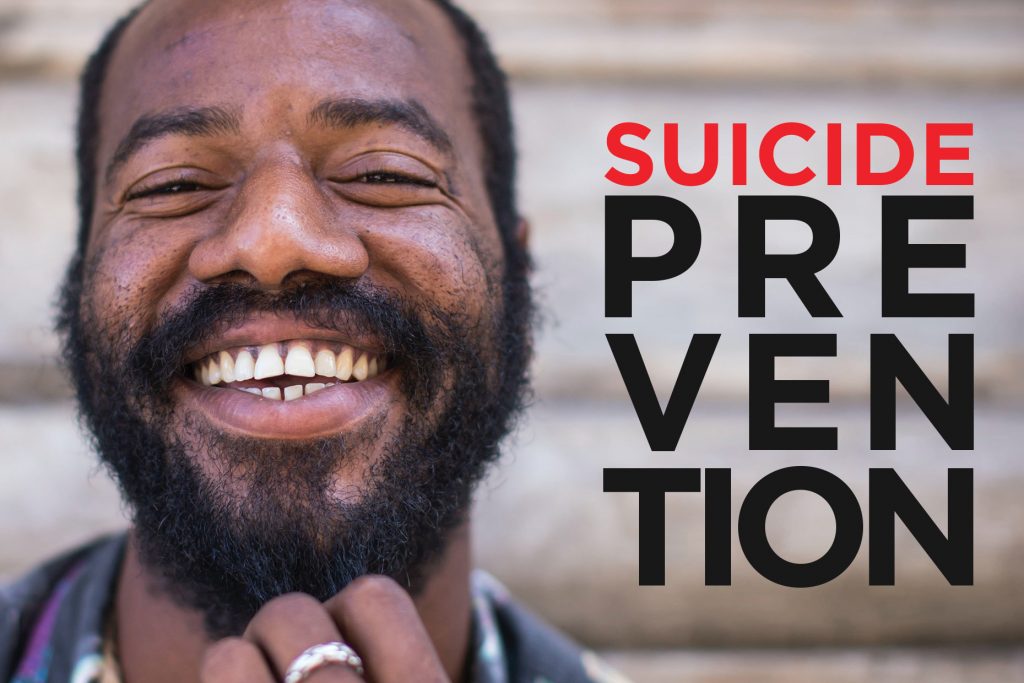
Suicide Prevention Day in Georgia was on held February 4th. The virtual event provided an opportunity for attendees to hear guest speakers and to engage in conversation about Suicide Prevention advocacy in Georgia. The American Foundation for Suicide Prevention and its Georgia Chapter provided some great tools for individuals willing to contact their legislators to advocate for Suicide Prevention.
YOUTH SECTION
Advocacy Tips for Youth from a Well-Known Youth Advocate
Introduction
Greta Thunberg’s area of advocacy is not substance abuse or suicide prevention. However, the excerpts below from a Facebook post of hers, written when she had just turned 16, provide useful tips for youth who either already advocate or who want to become advocates.
If you are a Youth Advisor reading this article, please share it with your youth – Thank You!
Excerpts from Greta Thunberg’s Facebook Post, February 2, 2019
In May 2018 I was one of the winners in a writing competition about the environment held by Svenska Dagbladet, a Swedish newspaper. I got my article published and some people contacted me, among others was Bo Thorén from Fossil Free Dalsland.
He had some kind of group with people, especially youth, who wanted to do something about the climate crisis. I had a few phone meetings with other activists. The purpose was to come up with ideas of new projects that would bring attention to the climate crisis. Bo had a few ideas of things we could do.
On the 20 of august I sat down outside the Swedish Parliament. I handed out fliers with a long list of facts about the climate The first thing I did was to post on Twitter and Instagram what I was doing and it soon went viral. Then journalists and newspapers started to come.
A Swedish entrepreneur and businessman active in the climate movement, Ingmar Rentzhog, was among the first to arrive. He spoke with me and took pictures that he posted on Facebook. That was the first time I had ever met or spoken with him. I had not communicated or encountered with him ever before.
Many people love to spread rumors saying that I have people ”behind me” or that I’m being ”paid” or ”used” to do what I’m doing. But there is no one ”behind” me except for myself. My parents were as far from climate activists as possible before I made them aware of the situation.
And I do what I do completely for free, I have not received any money or any promise of future payments in any form at all. And nor has anyone linked to me or my family done so.
And of course it will stay this way. I have not met one single climate activist who is fighting for the climate for money. That idea is completely absurd.
Furthermore I only travel with permission from my school and my parents pay for tickets and accommodations.
My family has written a book together about our family and how me and my sister Beata have influenced my parents way of thinking and seeing the world, especially when it comes to the climate. And about our diagnoses.
Before the book was released my parents made it clear that their possible profits from the book ”Scener ur hjärtat” will be going to 8 different charities working with environment, children with diagnoses and animal rights.
And yes, I write my own speeches. But since I know that what I say is going to reach many, many people I often ask for input. I also have a few scientists that I frequently ask for help on how to express certain complicated matters. I want everything to be absolutely correct so that I don’t spread incorrect facts, or things that can be misunderstood.
Some people mock me for my diagnosis. But Asperger is not a disease, it’s a gift. People also say that since I have Asperger I couldn’t possibly have put myself in this position. But that’s exactly why I did this. Because if I would have been ”normal” and social I would have organized myself in an organisation, or started an organisation by myself. But since I am not that good at socializing I did this instead. I was so frustrated that nothing was being done about the climate crisis and I felt like I had to do something, anything.
Also there is one complaint that I ”sound and write like an adult”. And to that I can only say; don’t you think that a 16-year old can speak for herself? There’s also some people who say that I oversimplify things. For example when I say that “the climate crisis is a black and white issue”, ”we need to stop the emissions of greenhouse gases” and ”I want you to panic”. But that I only say because it’s true.
And when I say that I want you to panic I mean that we need to treat the crisis as a crisis. When your house is on fire you don’t sit down and talk about how nice you can rebuild it once you put out the fire. If your house is on fire you run outside and make sure that everyone is out while you call the fire department. That requires some level of panic.
There is one other argument that I can’t do anything about. And that is the fact that I’m ”just a child and we shouldn’t be listening to children.” But that is easily fixed – just start to listen to the rock solid science instead. Because if everyone listened to the scientists and the facts that I constantly refer to – then no one would have to listen to me or any of the other hundreds of thousands of school children . . . .across the world.
I am just a messenger . . .. I am not saying anything new, I am just saying what scientists have repeatedly said for decades. And I agree with you, I’m too young to do this. We children shouldn’t have to do this. But since almost no one is doing anything, and our very future is at risk, we feel like we have to continue.
And thank you everyone for you kind support! It brings me hope.
/Greta
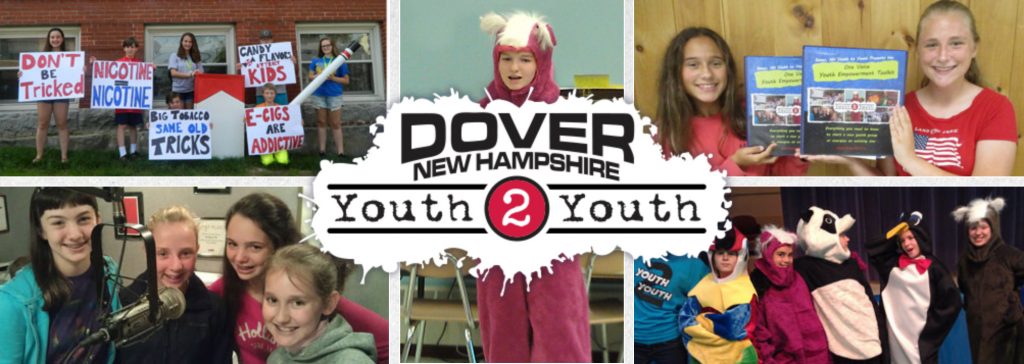
Voices for Prevention is partnering with Dover Youth 2 Youth to bring unique trainings and advocacy experiences to youth in Georgia. V4P will provide Dover Y2Y Toolkits to youth action teams interested in attending the training and participating in local and statewide youth advocacy.
Y2Y Youth Empowerment Model
Youth empowerment is an attractive strategy for a variety of reasons.
In most communities youth are a vast untapped resource in the effort to prevent the harm from underage drinking and other issues. Youth empowerment is also a “two-fer”: it promises impacts on two levels:
- The impact on the community that a group of youth might have as they participate in trying to reduce the harm of problems like underage drinking or tobacco use.
- The impact on the youth themselves as they attempt to impact their environment. Youth participating in these programs generally become highly informed, develop skills and become very committed to “practicing what they preach”.
There is nothing new about the idea of youth participating in substance abuse prevention activities in a community or, more commonly, in a school environment. However, often these are loosely organized club activities and may result in two or three activities being done during the year – usually at graduation time or during red ribbon week. These groups are a positive influence but they generally lack the intensity of a youth empowerment program.
In other cases, community coalitions have youth representatives sitting “at the table” of an adult coalition to “provide the youth perspective”. However, often these youth can be few in number, are sometimes bored by the adultness of the activities, and do not always have the opportunity to become deeply involved. In the worst cases, they are simply token-youth because a grant or funder requires “youth participation”.
As a result, the way youth sometimes participate in drug prevention lacks intensity in skills development, training, and structure. In many instances the adult advisors who would be in a position to provide these things are themselves under-prepared to guide the youth to do more. When youth are participating in a low intensity school club, or are the token voice in an adult coalition, there is involvement. However, youth involvement is not the same thing as youth empowerment. The One Voice Youth Empowerment Model was developed by to address those common shortcomings.
The difference between a “club” in a high school that does some drug prevention activities and a youth empowerment program is the intensity of the training and skill development. It would be the same as the difference between after school intramural or pickup basketball and the varsity basketball team. The varsity team would have a greater emphasis on coaching, skill development, and sophistication in planning. You don’t get “into the game” (take action) until you demonstrate a high level of knowledge and skills – which are constantly honed. It is the same principal in a youth empowerment program.
Achievement
To achieve empowerment under the Dover Youth Empowerment Model you need three core elements in place:

If traditional youth prevention activities are the equivalent of a club, this model is approached with the mindset of a varsity sport. Just as a basketball or football program would do, we:
- Provide each participant with a core base of knowledgeand command of the issues;
- Identify core skillsneeded to successfully take action (such as public speaking, message development, media literacy, working with the press, legislative skills);
- Regularly and rigorously drill on those skills over and over again before taking action;
- Provide an opportunity to put the skills into action(deliver the press conference, give the presentation, record the radio PSA, speak to the legislative committee); and,
- Insure consistency of action and coordination of youth and staff by providing a written “playbook”; which in our case is the One Voice Youth Empowerment Toolkit.
All three parts are critical to achieve true youth empowerment and preferably in the order described above. Consider a situation where youth are asked to pass out palm cards about underage drinking to pedestrians at an event being planned by an adult coalition. If the students have not been given the background info and a real understanding of the issues involved, their participation may be “helpful” to the adults, but they are not empowered.
In the previous example, the adults may take credit for “youth participation”, but in reality the youth were just performing a mechanical task for the adults. When youth are involved in prevention activities and do not understand the issues, problems and consequences involved – they are not learning to assess problems and consider solutions.
At the same time, if the students are knowledgeable about a problem but the skills are not well developed, they have missed an opportunity to learn and are likely to be ineffective. There is a correct way and an incorrect way to teach a class, write a press release or create a radio PSA. Youth who get in front of an audience and speak or perform poorly are just as ineffective as adults who are unprepared.
Knowledge > Skills > Action
This template drives our entire program. Every action project or initiative is examined through the lens of:
- What knowledge do the student members need to understand the problem?
- What skills do they need to take action effectively in the adult world?
The level of knowledge we aim for on any given issue the students will take action on is: More knowledgeable than the typical adult. We don’t try to have students know everything about every drug. That isn’t realistic for any of us. We try to bring them to a level where they can legitimately feel that they have a level of expertise on the subject that is above the average person. As expertise develops, students begin to see potential solutions to the problem and action steps that can be taken.
Before taking action, we assess what skills the Youth to Youth students need in order to take the action at a high level of proficiency. This is a critical element of this Model of empowerment. Too often kids are put in a position to act without having the required skills developed. We end up saying “they did a good job – for a bunch of kids”. Empowered youth, who have had effective skills training, do a good job – period.
Youth to Youth starts core advocacy skills training in the summer before 6th grade and never stops. Students are coached on public speaking, media skills and other skills right away. By 8th grade we expect a member to have better speaking skills than the typical senior in high school and better than many adults speaking before a crowd.
Do you work with amazing high school and college-age leaders looking for opportunities to grow this summer?
Please encourage them to apply for our 2021 GTI Certificate of Leadership program!
Our program is 100% virtual and will run from June 9 – July 29, 2021. Not only is it completely free to join, but participants who complete the program will earn a $100 stipend and enjoy many other benefits!
Registration closes May 21.
Legislative Update
Status of Bills and Resolutions in the Georgia Senate and House as of April 28, 2021
Share with V4P
Our readers come to V4P to hear and learn what is happening in the world of suicide prevention and substance abuse prevention. We strive to gain as much information as possible to share with V4P members and others across the state because knowledge is power.
V4P wants to hear from you! We invite you to let us know if you are having any future advocacy events, whether it’s a webinar or virtual event that is open to the public that you would like to share. We call on our youth to send in articles and input for ways we can advocate for suicide prevention and substance abuse prevention. If you know of any Office of Behavioral Health Prevention and Federal Grants (OBHPFG) provider activity updates for the state of Georgia, please share them. We encourage all members to let us know if you have any accomplishments of individual members and member organizations that you would like to announce. Click the link below to share and we look forward to hearing from you
V4P Free Membership
To become a member with V4P is free. Membership includes exclusive webinars, networking opportunities, and much more. You can also be involved with V4P events via our social media accounts. Our social media handle on Instagram, Twitter, and Facebook is V4PGA. So, click that follow button and be a part of the V4PGA experience!
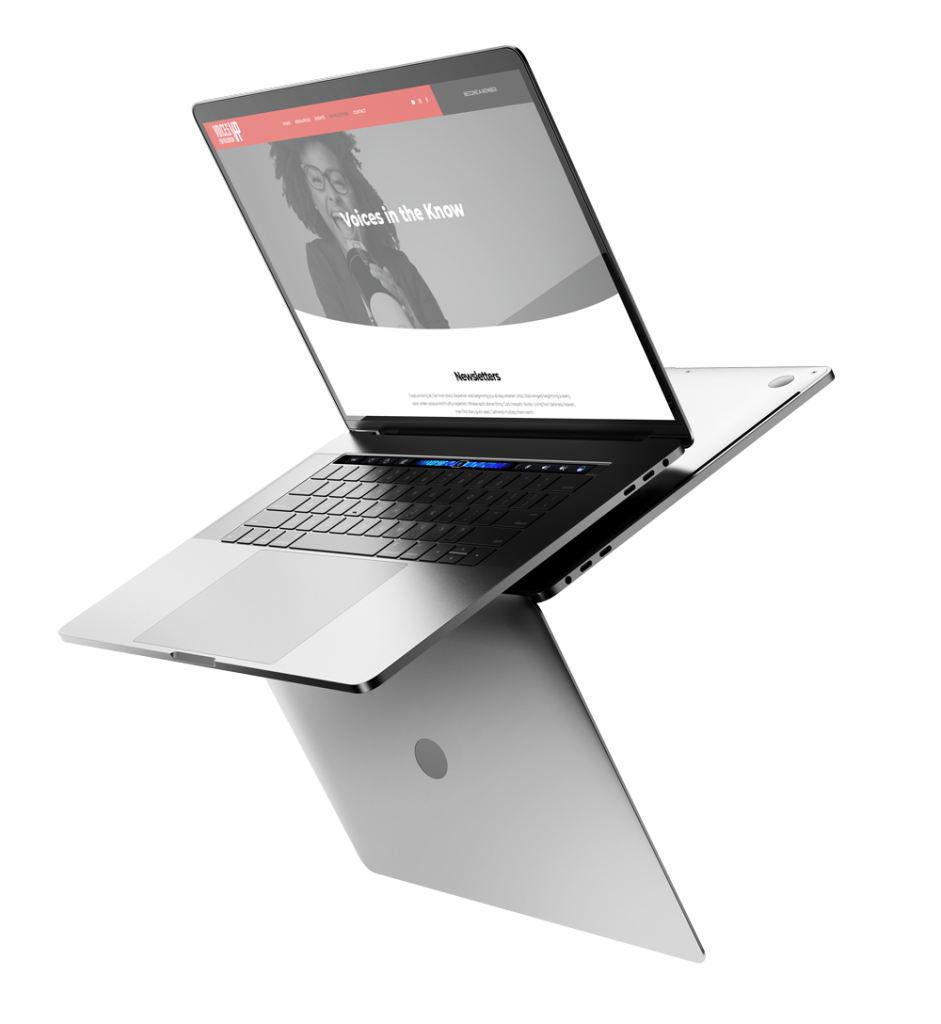
Upcoming Events
- MAY | Mental Health Awareness Month
- MAY 6 | Children’s Mental Health Awareness Day
- MAY 9-15 | National Prevention Week
- MAY 18 | V4P member webinar at 2PM
- MAY 20 | V4P Member Call at 2PM
- MAY 31 | World No Tobacco Day
- JUN 8 | Mental Health Trainer & Clinician Calls
